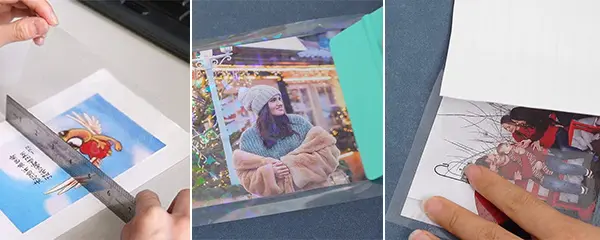
Why is my laminating film not sticking?
2025-01-17
2025 Spring Festival Holiday Notice
2025-01-24Cold laminating film is a popular tool in the world of crafting, printing, and graphic design. It offers an easy and efficient way to protect printed materials, preserve photographs, and create lasting surfaces. While many people assume that cold laminating requires a machine, the truth is that it is possible to use cold laminating film without a machine. In this article, we will explore the different methods of applying cold laminating film manually, discuss the pros and cons of each approach, and provide helpful tips to achieve the best results without the need for specialized equipment.
Is It Possible to Use Cold Laminating Film Without a Machine?
Yes, you can absolutely use cold laminating film without a machine. Although a laminating machine can make the process quicker and more precise, it is not essential for achieving great results. Many people choose to manually apply cold laminating film to their projects, especially when working with smaller items or when they don’t have access to a laminating machine. The process simply involves applying the film by hand and using pressure to ensure that it sticks smoothly.
Some methods for applying cold laminating film without a machine
1. Manual Application Using a Ruler and Craft Knife
One of the easiest methods to apply cold laminating film manually is by using a ruler, craft knife, and a steady hand. Here’s how to do it:
1: Cut the cold laminating film to the size of the document or material you want to laminate.
2: Peel off the protective backing from the adhesive side of the film.
3: Carefully align the film over the item, ensuring it is centered and covers the entire surface.
4: Use a ruler to smooth down the film, starting from the center and working outwards to prevent air bubbles.
5: If there are any excess edges, trim them with a craft knife for a clean, professional finish.
2. Using a Credit Card or Squeegee
If you don’t have a ruler or craft knife, you can use a credit card or squeegee to apply cold laminating film smoothly. This method is similar to using a ruler; you’ll use the card or squeegee to apply even pressure instead. This method works particularly well for larger surfaces. Please adhere to the following steps:
1: Cut the film to the correct size for your material.
2: Peel off the backing and carefully place the adhesive side of the film on the surface you are laminating.
3: Use a credit card or squeegee to press the film down, starting from the middle and moving outwards to avoid air bubbles.
4: Once the film is applied smoothly, use the card to work out any remaining air pockets.
5: Trim the edges with a craft knife for a clean finish.
3. Roll and Press Method
Another method involves rolling the cold laminating film onto the surface using your hands. This is an excellent technique for larger projects or when you need a quick solution. Please follow the steps below:
1: Cut the film to the desired size and peel off the backing paper.
2: Gently align one edge of the film with the edge of the material.
3: Slowly roll the film across the material, applying even pressure with your fingers to ensure the adhesive sticks.
4: After the film is in place, use a flat object (like a wooden block or the back of a spoon) to press the film down and remove any air bubbles.

3 methods for applying cold laminating film
Advantages of Using Cold Laminating Film Without a Machine
There are several benefits to manually applying cold laminating film, including:
Cost Savings: Cold laminating films are generally affordable, and using a machine can often be an additional expense. By applying the film by hand, you eliminate the need for expensive equipment.
Portability: A laminating machine requires a stable work surface and a power source, while manual application can be done anywhere, making it more convenient for small jobs or on-the-go projects.
Control and Precision: When applying cold laminating film manually, you have full control over the process, allowing for precise application and the ability to correct any mistakes along the way.
Challenges to Consider
While there are several advantages to applying cold laminating film without a machine, there are also a few challenges to keep in mind:
Time-Consuming: Manual application can take longer than using a machine, especially if you are working on larger projects or laminating multiple items.
Risk of Air Bubbles: One of the most common issues with manual lamination is air bubbles. However, with the right technique, such as using a ruler or squeegee, you can minimize this problem.
Less Precision: It can be more difficult to achieve the level of precision that a laminating machine provides, especially for larger or more intricate items.
Tips for Achieving the Best Results
To ensure that your cold laminating film application is successful, follow these helpful tips:
Work Slowly: Take your time when applying the film to avoid mistakes. Carefully align the film with the material and use even pressure to ensure a smooth finish.
Use a Clean Surface: Dust, dirt, and debris can interfere with the adhesive’s bond. Make sure the surface you’re working on is clean and free of any particles.
Test on Scrap Materials: Before laminating your final project, test the cold laminating film on a scrap piece of material to ensure it works as expected.
Apply Even Pressure: Whether you’re using a ruler, squeegee, or your hands, make sure you apply even pressure to ensure that the film adheres properly without air bubbles.
You can use cold laminating film manually, making it an effective and affordable solution for various projects. Whether you want to protect photographs, preserve documents, or enhance printed materials, manual lamination can yield excellent results. By following the outlined methods and tips, you can confidently laminate your materials without a specialized machine.
Related:
What is cold laminating film for?
Types of Cold Laminating Film
Why is my laminating film not sticking?

